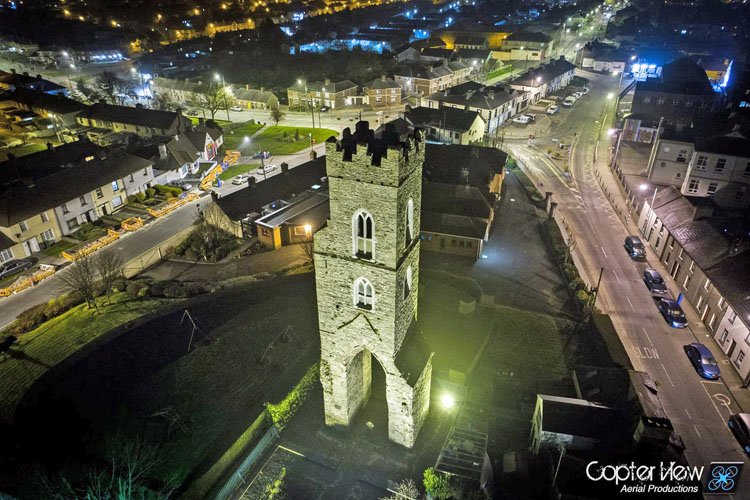By Sean Collins
It is a prominent building close to a busy junction on the North side of Drogheda, somewhere that many of us pass on a daily basis without giving it a thought. For his look at local landmarks and history this week, historian Sean Collins reveals some of the stories associated with the 13th century Magdalene Tower.
The Dominican Order (Order of Friars Preachers) arrived in Ireland in 1224, they established two houses, one in Drogheda and the other in Dublin.
At the behest of the Archbishop of Armagh, Luke Netterville, the foundation at Drogheda was established on a Northern slope, high above the town. The castellated tower dominates the northern skyline to the present day.
The site was already occupied by a convent of nuns and the chapel of St. Mary Magdalene, alongside a leper hospital.
The friary received Royal support in 1253 and 1285. It was noted that in 1300 and 1330 wrongdoers took sanctuary in the church. In 1337 three of the friars were found guilty of beating up two of their brethren. Some things never change!
In 1412 a complaint was made to the king that blood had been shed in civil strife between the townsmen on each side of the river. Fr. Philip Bennet, a Master of Theology at the friary, invited both sides to the Collegiate Church of St. Peter on nearby St. Peter’s Hill where he preached so movingly, that both sides agreed a peace, concluding with a feast in the friary.
A parliament held in Drogheda in 1468 granted an annual subscription to the friary because it had fallen into disrepair following attacks by English enemies and Irish rebels.
The tower of St. Mary Magdalene’s friary, sometimes called St. Sunday’s Steeple, because of it’s proximity to the medieval St. Sunday’s Gate, is described by architectural historian Christine Casey as “this elegant Gothic tower is an addition to an earlier church thought to have been a narrow cruciform structure with a belfry”.
“The tower consists of a tall, pointed arch with two rooms above and a stairwell at the N W angle. The upper windows appear to be of early 14th century date, in which case this is the earliest stone belfry to a friary church in Ireland”.

On the 16th of March 1394, four Ulster chieftains led by Niall Og O’Neill , O’Hanlon, McDonnell and McMahon in the king’s rooms of the Dominican friary at Drogheda, took an oath in the presence of King Richard II, translated as:
“I, Niall junior, captain of my nation, swear to be faithful liegeman of my Lord Richard, King of England and France, Lord of Ireland, my sovereign lord, and of his heirs and successors, being Kings of England, from this day henceforth. So help me these God’s holy gospels”.
So perhaps the beginning of the end of the old Irish Chieftains had begun.
In 1540, during the suppression of the Irish monasteries by Henry the eighth, the Magdalene site was surrendered by the last Prior Peter Lewis and the properties granted to Walter Dowdall and Edward Beck.
By this time the Dominican Friary was already in ruins with only the tower in good order. The site consisted of ten acres and five messuages (a dwelling house with outbuildings and land).
Throughout the 17th century the site was densely populated, covered with mud walled cabins surrounding the tower. It is said that Luke Netterville and his successor Patrick O’ Scanlon are buried there adding to the tally of Archbishop’s of Armagh of one side or the other buried in Drogheda.
Lady Margaret Bermingham wife of Lord Preston was buried there in 1361. The Earl of Desmond and Lord Deputy of Ireland was beheaded on the North Commons or Gallows Lane in Drogheda in 1467 and his remains were interred in St. Magdalene’s but were later re-interred in Dublin or possibly Tralee depending which source you read.
In 1890, the local authority tidied up the site and put the railings around the perimeter. Unfortunately, in 1993 the same local authority, in an attempt to clean up and preserve the tower, had the beautiful sandstone window jambs replaced with cut limestone ones so unlike the originals. They claimed at the time that they were preserving the tower………….by removing it’s original features ?????
The most popular local ghost story associated with St. Magdalene’s is that of the ghostly woman that appears in the belfry, perhaps inspired by the ornamental cherub heads on the arch.
Could it be Lady Preston or one of the medieval nuns of Mary Magdalene? Mary Magdalene was born in Magdala, a town on the coast of the sea of Gallilee. Magdala from the Hebrew word meaning a “tower”.






